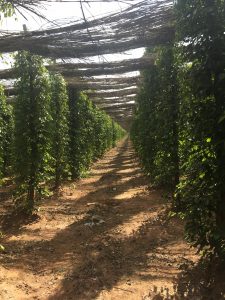Kampot Pepper is considered the best pepper in the world by many because of its unique flavor, aroma, and terroir. Kampot Pepper is a variety of pepper grown in the Kampot province of Cambodia, which is known for its fertile soil, tropical climate, and unique terroir that includes a clay rich soil containing quartz.
The terroir, or environmental conditions in which the pepper is grown, plays a significant role in the flavor and aroma of the pepper. The soil and climate of the Kampot region, combined with the expertise of the local farmers who have been cultivating pepper for generations, produce a pepper with a complex flavor profile that is prized by chefs and food enthusiasts around the world.
Kampot Pepper is hand-harvested and carefully processed to ensure that only the highest quality pepper makes it to market. The farmers use traditional methods to cultivate the pepper, such as intercropping with other crops to maintain soil fertility and using natural fertilizers and pest control methods.
Kampot Pepper has been awarded protected geographical indication (PGI) status, which means that only pepper grown in the Kampot region can be labeled and sold as “Kampot Pepper.” This puts Kampot Pepper on the same footing as other ‘appellation of origin’ brands like: Champagne, Darjeeling tea, Cognac etc. This protection helps to maintain the quality and authenticity of the pepper and ensures that consumers are getting the real thing. Overall, the combination of unique terroir, traditional farming methods, and protected status contribute to making Kampot Pepper one of the most highly regarded and sought-after peppers in the world.

Kampot pepper comes in four varieties: green, black, white and red, all from the same plant (Piper Nigrum). The local climate offers perfect conditions for growing pepper and the quartz content of the soil helps to give Kampot Pepper its unique flavour. The growing conditions are only one of several elements of importance to the production of Kampot pepper. Knowledge of pepper cultivation and production has been handed down from generation to generation since at least the 13th century and was first described by Chinese diplomat Zhou Daguan when he visited the area during the height of the Angkor Empire.
We offer three of the four varieties. We occasionally have the fresh green peppercorns and they are a rare delight.
Green Pepper can be harvested at anytime and is used as an accent for many foods in Cambodian cuisine. The green fruit has a fresh citrus flavour and is less spicy than the dried varieties. Fresh green peppercorns are a rarity in North America as they have to be air freighted and have a limited shelf life. Green peppercorns are usually sold in a brine solution on this side of the pond.
Black pepper is harvested once some of the fruit begins to ripen (turn red). The green fruit is hand picked, sun-dried for two to four days and then hand-sorted by size. Black pepper has a deep, strong and slightly floral flavour with hints of eucalyptus and mint. It can range from mildly sweet to very spicy.
Red pepper. The ripened red fruit is left on the vine for an additional four months before being harvested, dried and hand sorted. Red pepper is sweeter and less spicy than the black but its flavour is more rounded, delivering a powerful fruity aroma
White pepper comes from dried red peppercorns. The fruit is soaked in brine for five minutes and sun dried. The outer skin is rubbed of by hand to reveal the white inner core. This is the most delicate of peppers and carries notes of fresh herbs and lime. White pepper is used in French pastry and has even been used to make ice cream.

